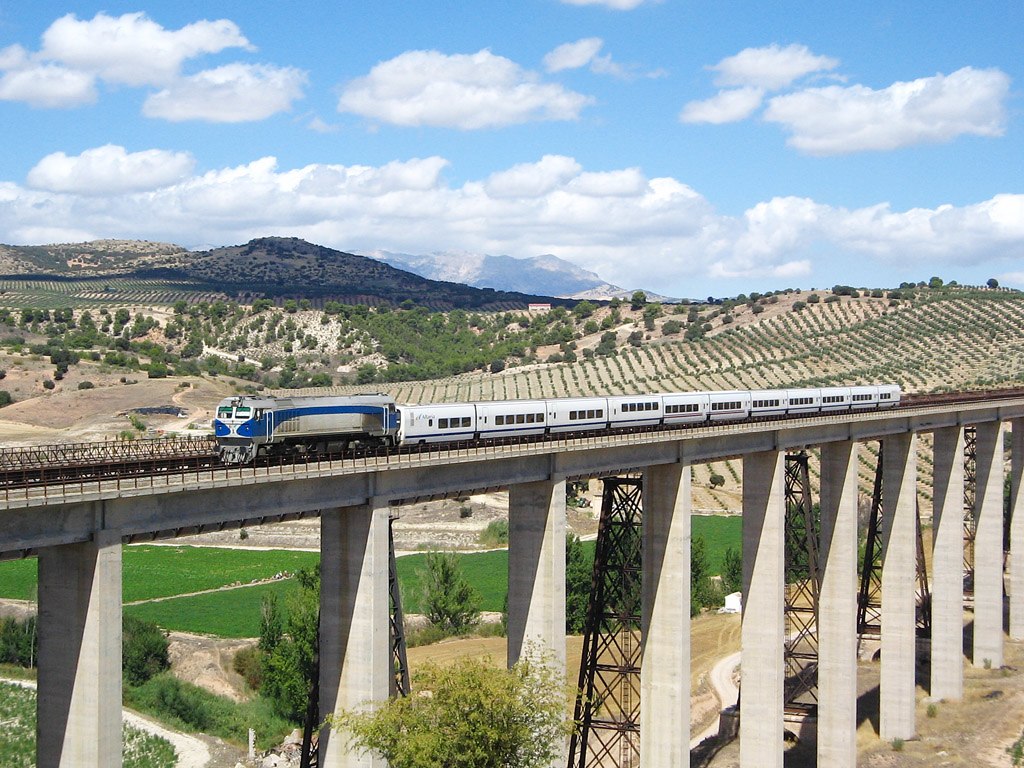
Training young
As soon as I got home from my primary school – if the weather was OK – I would meet up with my friend Norman to go train spotting at the railway line, which was about a mile away. I was very proud of my Ian Allen Trainspotters booklet, with so many venerable steam locomotives ticked as having been spotted on our daily outings to the railway line. In those days many of the steam engines had romantic names (or so they seemed to us) like ‘City of Truro’, ‘Blandford Forum’ and ‘Pendennis Castle’. I’ve never forgiven British Railways, as it was then, for replacing steam with boring diesel-electric trains on ‘my’ train line … or Norman for ‘borrowing’ and never returning my Ian Allen book!
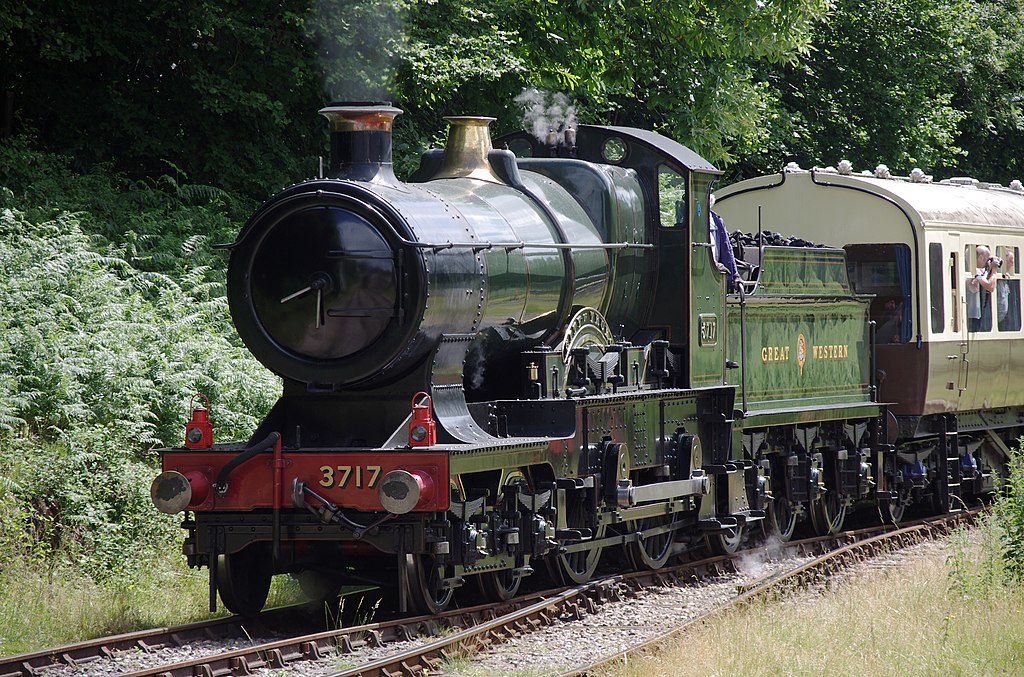
However, trains have always held a fascination for me, hence my enjoyment of a couple of significant train journeys over the last 25 years or so. The first was a journey to a conference near Lyon in the late 1990s. The aging GWR (Great Western Railways) HS 125 got us the 200 miles to London in around 3 hours … average speed around 60mph.Compare this withRailways: the Eurostar train which trundled along to the Channel Tunnel, sped up through it, then built up to full speed to Lille – 200mph. From there, the TGV (Train à Grande Vitesse – high speed train) covered the 430 miles to Lyon in less time than we had taken to get from Totnes to London … and at half the ticket price. The TGV has been operated on a comprehensive network of lines in France since the 1970s.
The train in Spain
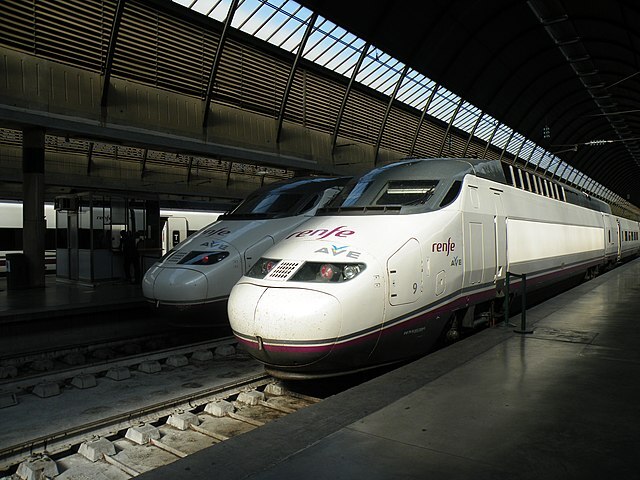
My second memorable train journey was from Málaga to Madrid in the autumn of 2019, a couple of months before the Covid pandemic struck… 330 miles in just over 2 hours, at a very affordable price, in the AVE (Tren de Alta Velocidad – high speed train, operating since 1992). The display screens on this train showed that we were travelling at 200 mph for much of the journey. Both the SNCF (Société Nationale des Chemins de fer Français – French national railway society) and RENFE (Red Nacional de los Ferrocarriles Españoles – Spanish national rail network) are nationalised … just as British Rail used to be … can’t be such a bad idea. I remember when our railways were privatised in 1997 – a commentator prophesied problems:
“Imagine a South Western local train’s brakes fail as it approaches Newton Abbot station, and it crashes into the back of a GWR train. Each train company would sue the other for damages, Network Rail would sue them both for blocking its track, and other train operators would sue them all for messing up their services. The winners? You’ve guessed it … the legal eagles! … or should it be vultures?”
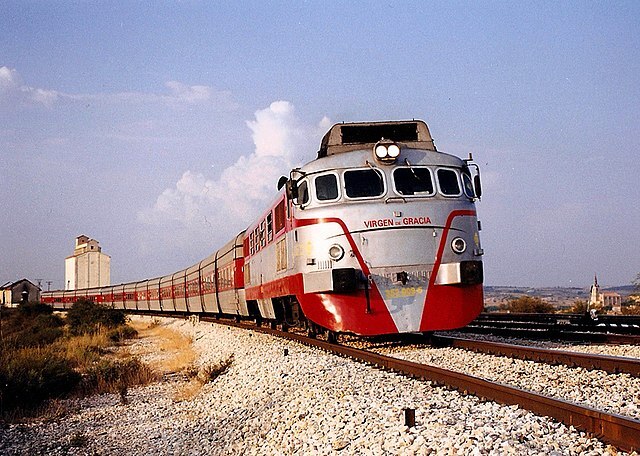
Being nationalised has never prevented Spanish railways from developing new rail technologies for the future. Few people are aware of the TALGO (Tren articulado ligero Goicoechea-Oriol) a lightweight articulated train – Goicoechea and Oriol were its inventors in the late 1940s. The tilting TALGO pendular trains were introduced in the 1970s; TALGO trains are operated around the world in countries as diverse as Russia, the US, Canada, Argentina, Kazakhstan and Uzbekistan. The AVE design has been sold abroad too, such as ‘el tren del desierto’ (desert train), and the AVE which links Mecca and Medina in Saudi Arabia.
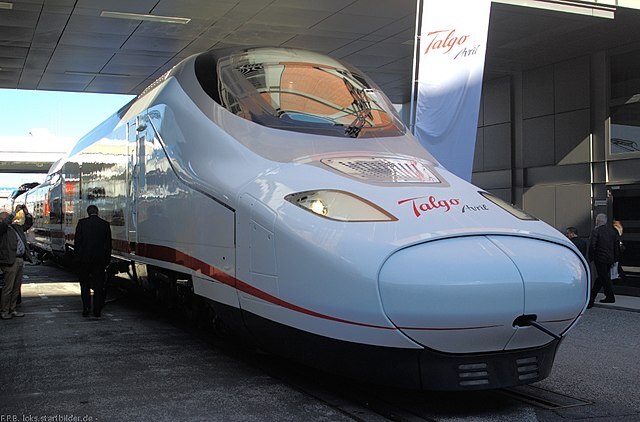
The rain in Spain will come from a hydrogen train …
Now for the latest development in Spanish railway technology: Spain is developing hydrogen-powered trains. In an article earlier this year, El Mundo asks: “¿Será el hidrógeno la próxima revolución del ferrocarril? (Will hydrogen be the next revolution on the railways?). The article introduces the topic with a bit of history: “El tren es sinónimo de revolución. Desde la aparición de la locomotora de vapor en 1803, este medio de transporte ha contribuido al desarrollo económico, conectando de manera sostenible a millones de personas y lugares remotos.” (The train is synonymous with revolution. Since the appearance of the steam locomotive in 1803, this mode of transport has contributed to economic development, linking in a sustainable way millions of people in remote places).
The article goes on to mention a few significant steps in the development of railways, and notably the fact that it is now over 30 years since the inauguration of the first Alta Velocidad (AVE) high-speed route in Spain, between Madrid and Seville in 1992. Even more significant is the fact that Spain can proudly boast of being ‘líder mundial’ (world leader) in having the most high-speed track per inhabitant and square kilometres.
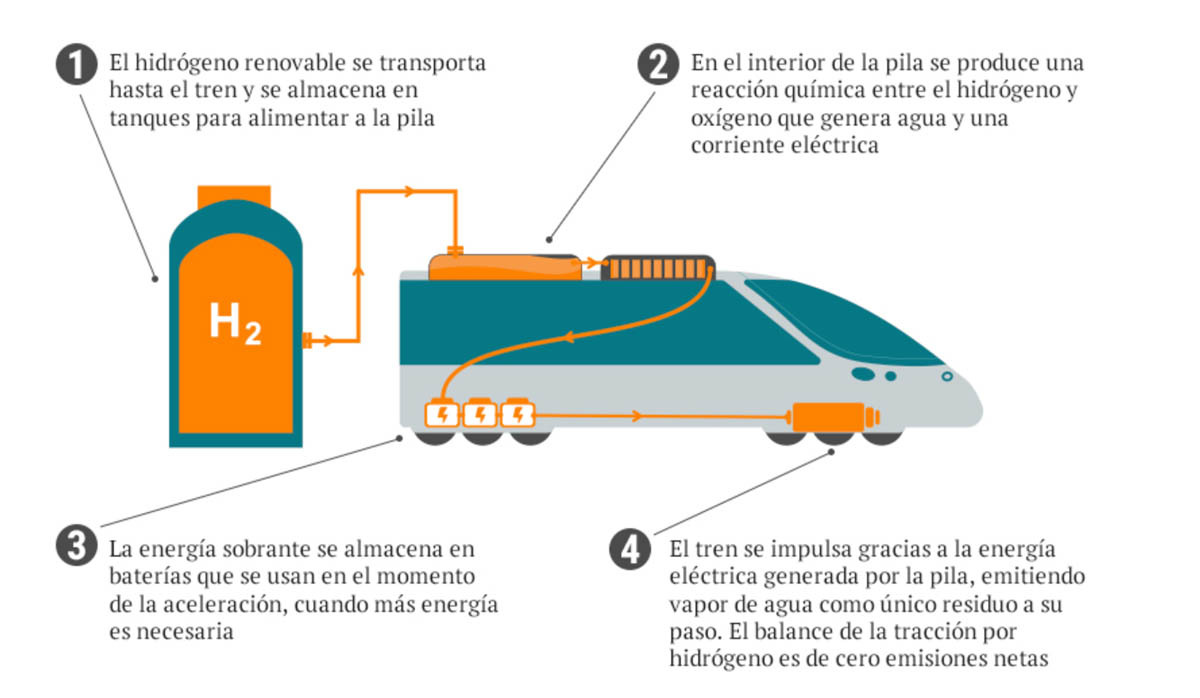
So, what is the news about hydrogen-powered trains in Spain, as reported in El Mundo back in May? Necessity: although much of the Spanish rail network is electrified, notably the routes used by the AVE and related high-speed trains, there are 5.536 kilometres of non-electrified lines; to electrify them would cost an average of 500,000 euros per kilometre. The Spanish government plans to develop two routes with trains running on renewable hydrogen before 2030. These trains will have hydrogen batteries, in which the hydrogen interacts chemically with oxygen, producing an electric current … and water. Excess electricity is stored in batteries to be used for extra power when the train accelerates. Significantly, the Spanish fuel company, Repsol, is a key partner in this project, along with Talgo, who will develop and construct the trains. So, these trains will produce electric power from hydrogen … and the only waste emissions will be water vapour!
Talgo has already developed a train called Vittal One in which this technology is being tried out on the tracks. This train will be used on secondary lines which are not electrified. Meanwhile, Repsol will use its existing distribution network to provide the hydrogen. Emilio García, Talgo’s director of innovation and patents, says that with traction provided by green hydrogen, this is a form of zero emissions transport which makes a considerable contribution to reducing emissions and decarbonising the planet.
EU hydrogen …
Spain will in fact be joining Germany and France in the hydrogen train club. Germany already has hydrogen trains in regular use, and France’s first hydrogen train will come into service this year. As for the UK, the Guardian has reported that the British firm, ITM Power, which makes electrolyser machines, says splitting water using renewable energy to produce ‘green hydrogen’ has become more cost-effective than gas; as the Guardian explains, it is “net zero energy gas”, clearly more beneficial for the environment to produce than ‘grey hydrogen’, which is produced from fossil gas. Besides, this process could counter the energy crisis resulting from the war in Ukraine, which has made it more viable and desirable. As the Guardian also revealed back in August, Scottish Power plans to build a £150m green hydrogen plant at the Port of Felxstowe, which could power trains, trucks and ships. It seems that hydrogen is the way to go!
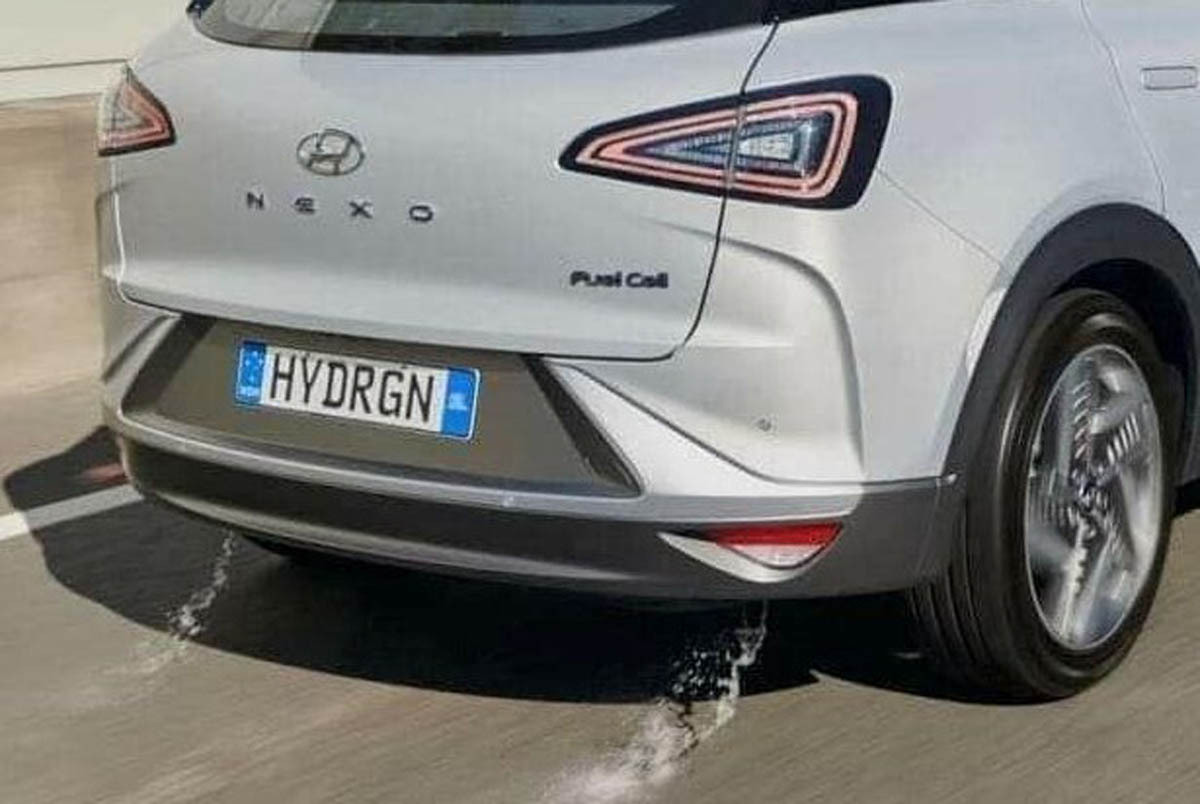
So, what about cars? Our government has put all the emphasis on electric cars; however, they are so expensive to buy that they are beyond the reach of many people. Much has been said and written about problems of range; additionally, one wonders how e-vehicle owners are going to fare when they have to replace their hugely expensive batteries, which will happen sooner or later. Last week I ‘attended’ an online seminar from Pirelli Tyres UK, in which it was explained that new tyres had to be produced with different compounds and more resilient structures to cope with the extra weight of electric cars: batteries are heavy! Tyre suppliers are reporting that the tyres on electric cars are having to be replaced after as little as 8,000 miles. My local tyre depot has made the same comments … ironic then that electric cars are currently exempt from vehicle excise duty, even though they are likely to be causing more wear and tear on road surfaces than other cars. This exemption will end in April 2025; the government seems to have woken up to this anomaly. Perhaps they have put too much emphasis on just one alternative to the internal combustion engine. Hydrogen-powered cars already exist, and will ultimately be the future, if an article in the RAC on-line magazine is anything to go by. In fact, hydrogen cars from two Japanese manufacturers are already available in Australia; two major advantages are that they actually purify the air they travel through, and their range is greater than that of electric cars!
Back on track
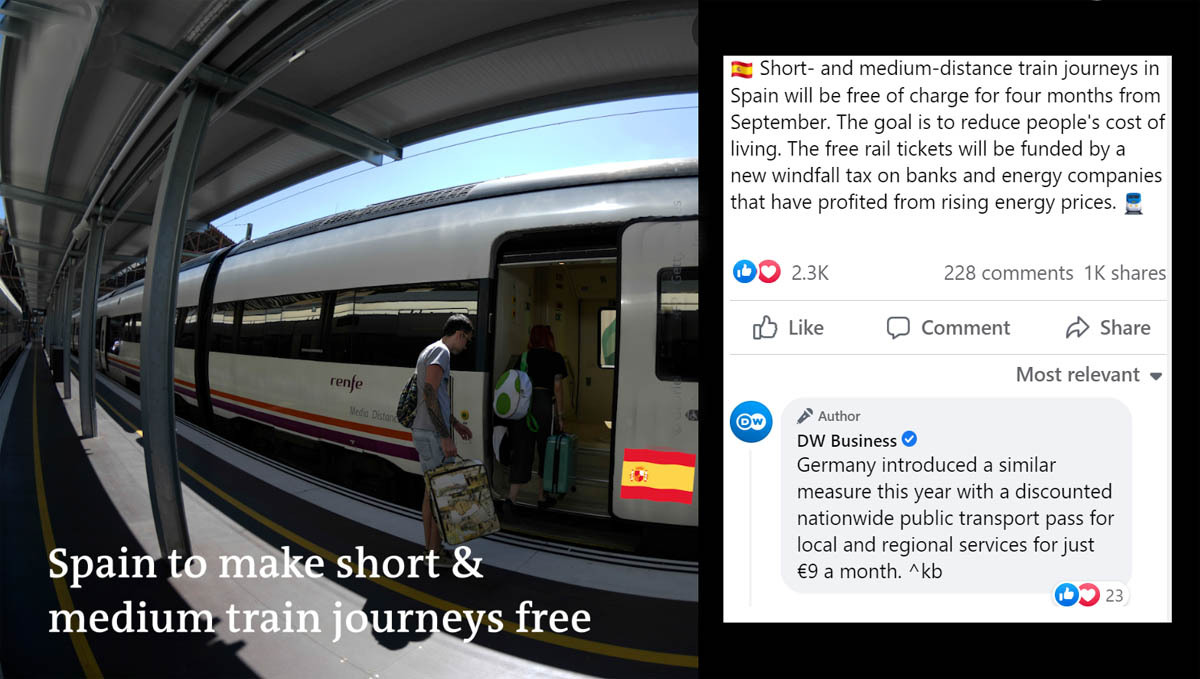
Let’s get back on track: the point which is obvious to draw from what we’ve seen so far is that the advantage of a nationalised rail system is that it is run for the benefit of the citizens, not for the profits of its shareholders. For example, back in July in the face of the developing economic crisis, the Spanish government was able to announce financial help for its citizens: Catalán News announced huge reductions on ticket prices for four months … paid for by additional tax on big energy companies. In a Facebook post the German broadcasting and media production company DW Business reported:
“Short- and medium-distance train journeys in Spain will be free of charge for four months from September. The goal is to reduce people’s cost of living. The free rail tickets will be funded by a new windfall tax on banks and energy companies that have profited from rising energy prices .…”.
Then in the same Facebook thread:
“Germany introduced a similar measure this year with a discounted nationwide public transport pass for local and regional services for just €9 a month.” Not surprising that in response came the comment: “That is how to run an economy. For the people not for shareholders.”
The fallacy used to justify privatisation of British Rail back in 1997 was that in a privatised railway system competition would make the railways more efficient. Hmmm … I’ve never seen trains run by different companies racing on parallel tracks. The current farcical rail situation in the north of England is receiving much publicity, not least because of the emergency ‘summit’ held recently by the mayors of major northern cities. By contrast, in a recent Radio 4 phone-in (29 November), one caller reported how he had been about to leave his Paris hotel to catch a train: he received a text message from SNCF warning him that the departure of his train was going to be delayed by … 5 minutes. Other callers also reported their experience of fast, efficient, punctual and cheap rail travel in Europe, contrasting with those lamenting the pitiful rail service in the UK.
A very recent example of the scandalous treatment of rail passengers in the UK is described in an article which appeared in the Guardian:
“Masterclass in poor service: rail passenger hits out at Avanti over £589 ticket”.
The passenger was charged this outrageously astronomical price for a First Class ticket from Brighton to Bangor. The current national rail strikes in the UK are not exactly unexpected, given the economic situation, but the fragmentation of the rail service can’t make for easy resolution.
The bogey of privatisation

When it comes down to it, the quality of national public services depends on the government (and arguably the public gets the government it deserves!) The French government may not be perfect, but their announcement on 5 December concerning short-haul flights and the use of private jets is both breathtakingly sensible and logical – joined-up thinking, tackling an aspect of transport contributing to climate change. According to UK Yahoo News:
“The European Commission has approved France’s bid to ban short-haul flights where there is a reliable rail alternative that takes under two and a half hours”.
Hmmm … that Brexit ogre, the European Commission.
Furthermore, Euronews.green adds the report that:
“France is also cracking down on the use of private jets for short journeys in a bid to make transport greener and fairer for the population. Transport minister Clément Beaune said the country could no longer tolerate the super-rich using private planes while the public are making cutbacks to deal with the energy crisis and climate change.”
So, we see examples of how a coherent government transport policy and nationalised rail services are the best way to provide a good train service … to the benefit of citizens, not shareholders. The huge irony, however, is that some of these EU nationalised rail companies are able to profit from the British taxpayer, as reported in the Daily Mirror back in August. And not just our railways: think how many other public utilities on the Monopoly board are now, at least in part, owned by foreign companies, whose shareholders profit, thanks to UK government subsidies for those utilities. As for the railways, this video explains it all … yet again my beloved country, the UK, is the laughing stock of Europe.





